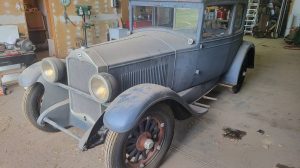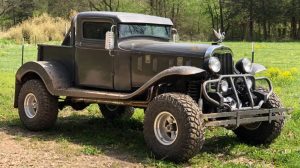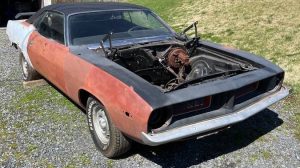One of the more dangerous project acquisitions is the rare car that has issues that might otherwise cause you to pass if it weren’t a desirable model. In this case, it’s a genuine 1963 Studebaker Avanti R1 that needs restoration, and also has some fairly troubling rust in the frame and hog troughs. The seller lists a few other issues, stemming from some rough cosmetics, primarily. It’s a project, but potentially a worthy one. Would you bring this Avanti back to life? Find it here on eBay with a Buy-It-Now of $4,900.
Thanks to Barn Finds reader Russ D. for the find. The seller is refreshingly honest about the condition of this sad Avanti, noting that in addition to the fairly serious rust, it also has a horrible paint job and numerous missing parts. The way the description reads, it sounds as if someone attempted a restoration but didn’t get very far, or do the work to a very high level. Things like the windshield being replaced but then being cracked when it was installed are tell-tale signs, along with a big brake conversion that was never finished and is missing parts.
The valve covers were treated to new chrome, along with the bumpers – but doesn’t that seem like an odd thing to prioritize when you’ve got rust in the frame? That’s another sign (to me, anyway) that the previous owner didn’t have a his sights set on completing a high-end restoration but rather just making this Avanti pretty without getting into the ugly stuff. The good news is the stock 289 V8 still fires up and cranks with the key, and it comes with a new “suitcase”-style battery. Numerous parts are missing, however, like the brake booster, air cleaner, and ignition shielding, among others.
There’s a few photos of the frame damage, and it’s hard to ignore. The seller notes that it seems possible the Avanti was a coastal resident, with the salt air wrecking havoc with structural components like these. Other missing parts include the headlight covers, door panels, bumper guards, stainless steel trim, hubcaps, and of course, the braking components that didn’t migrate over when the seller began the big brake conversion. It’s certainly a cheap R1, but it needs an awful lot – is it worth restoring?















Of course with an Avanti the first question is “How are the Hog Troughs?” I have no idea what hog troughs are as relates to an Avanti. But it’s always the first question.
Pretty sure those rotted cavities in the frame are thr hog troughs
That is the rear rail of the frame between the loop for the differential and the rear leaf support. No weep hole causes this not a large job. I am sure the other side is the same way. Studebaker international sells a rail for this around $100. A lot of labor cutting out lower the rear leaf grind, weld and paint. Shop charge for both sides less than $2k. If you can weld $200.
The hollow steel box structures under the floor just inside the rocker panels are the hog troughs. Studebaker frames tended to be narrow with lots of space between the outside of the frame rails and the rocker panels. They used that space for body reinforcement using boxed sheet metal sections that rusted readily. The other rotten metal showing in the photos are the rear frame rails and round rear cross member. They reproduce the hog troughs but I’ve no idea how difficult it is to replace them. The rear cross member is reproduced in stainless, and used frames are out there. I hope this gets saved. Nice R1 with factory AC.
Hog troughs are the slang term for torque boxes that mate the fiberglass body to the steel frame. Replaceable, but it appears you’ll need a frame too. Those can be found in the Avanti community along with new frames made by Art Morrison Chassis. Get out your wallet and set aside lots of time. Or get a reality show to do it for you in 24 hours!
Maybe 24 hours of actual film time. I am not sure that I want anything that was done in 24 hours. Love the Avanti, great styling.
Low quality assembly to start with.Our family doctor had one and the windows leaked and there were other issues.The whole idea behind the Avanti was a
guarantee of failure in the market,a corporation hot rod.
Please elaborate on the phrase “corporation hot rod”. Sounds like a great idea to me, but I am an engineer, ex-mechanic, ex-dyno technician.
Engineers may make up fine engines but stylists sell the cars and most of us are not interested in a car that can do 150 MPH on the test track.The Avanti’s styling was different but problems soon appeared with the poorly fitting widows and
the demonstrator that I drove had an unacceptable level of noise in the cabin and wind whistle at highway speeds.
I bought a one year old Lark with a small V8 and a standard with overdrive transmission and I am still convinceed the whole car was built for $20 and traded it in on a new Plymouth Belvedere.
Shame you had bad experiences with Avanti’s. I have spent a lot of time with them building a race car. I was amazed at the quality of the moldings and the engineering, especially in the area of the side windows and frames. There are multiple adjustment points for the front window fit and frankly when properly adjusted are impossible to deform to caused airleaks. Of course settling does occur with GRP construction and adjustment is occasionally required. The unfortunate ‘hog troughs’ were Studebaker’s answer to a structural interface between the GRP and the steel chassis, prone to water ingress and rusting, especially due to the thin gauge of metal which was adequate for the structure but not for that nasty habit of pouring salt on roads. I did away with these structures by introducing internal GRP sills and the ‘I’ beam nature of that inclusion easily caters for this transition point. Sadly there was less faith in composite materials in the early sixties so that type of remedy was insisted upon by ‘old school’ engineering principals. Bit like putting a steel bridge structure in the wing of your ‘Dreamliner’ to be safe.
Peter, you deserve more than just a “like” for your post. These are the types of answers that I like to read. Thank you for sharing your experience & vast knowledge. Like they used to say on “Schoolhouse Rock”, “knowledge is power”.
Kind Regards, JMB#7
Solid explanation! Thank you!
I absolutely love the looks of the 63’s,but after maybe a decade of fixing up one then another ,I’ve concluded that nothing is more expensive than a cheap Avanti…take out a loan and seek out a better one.And today parts are scarcer and cost more than ever.
Agree with Bob Roller above. This was the era that Studebaker was attempting to “save” themselves by building ugly, crappy cars; go figure. The exception was the Avanti, which was beautiful but unfortunately suffered the other maladies of Studebaker. Too bad this one was allowed to deteriorate so greatly.
Why is it you never hear about “hog troughs” on other Studes, such as the Lark? Did they not have them?
No the Avanti is the only one to have them.
It’s a study just to try and figure out why the independent makers all finally
failed.Oddly enough,Studebaker was the last one to go.Packard’s poor 1954 sales was no help to them and the 1955 did attract attention but the Ultramatic gave them a bad reputation plus the inability to raise financing for new models was a death sentence.Banks and insurance companies wanted nothing to do with Packard’s sullied reputation.Nash and Hudson were not bad cars but they had the same labor costs as Ford and GM and not enough sales to support continued production.One article I read said that the day shift at Hudson was working and an announcement came over the
speaker system that said “As of 4PM today,the Hudson car company will cease all operations”.No warning at all.Nash had some good cars and in 1932 they made a car that was called the “Kenosha Duesenberg” because of it’s appearence.
Getting back to Studebaker,weren’t the last ones built with Chevrolet engines and transmissions in Canada? There was some scuttlebutt about GM being in hot water with the U.S.Goverment,some sort of anti trust thing.
The last two model year Studebakers (1965 and 1966) were built at the Canadian Studebaker plant in Hamilton, Ontario with engines sourced from Chevrolet. From what I’ve read the cars continued to use Borg-Warner transmissions.
A lot of work, off body, and about $40,000 to do right or 5 years or both.
Anyone considering this Avanti for purchase should be buying it only for parts. Hog troughs and frame both need replacing along with other items like missing chrome bumper pieces, new interior and other unnamed items. As said many times, “There’s nothing more expensive than a cheap Avanti”.
I’m an old car aficionado and have done much reading on this topic over the years. Studebaker apparently built good cars up to the early fifties, then decided to cheapen things. They ruined Pierce in the ’30s and destroyed Packard in the ’50s; I still hold them “accountable” for destroying two great marques in an attempt to save themselves. Must have been some self-serving horrible management!
John— My, My. A little mis-history going on there… Pierce was already on the ropes, which is why the firm was available for sale when Studebaker purchased them. No one in the early 30’s thought the Depression would drag on so long. The Depression is what killed Pierce, not Studebaker. And… it was Packard that bought Studebaker, not the other way around. GM and Ford were the primary Villains that killed the independents. Price wars from those two giant corporations were designed to kill all the independents.
OK, I’ll give you the one on Pierce, but it doesn’t change the story that some promote that Studebaker sucked them dry of cash and left them to die. They likely would have died anyway due to the depression. You are correct that Packard “bought” Studebaker, but Packard’s incompetent management turned everything over to Studebaker management who wisely took the Packard V-8, then destroyed Packard and went on to destroy themselves.